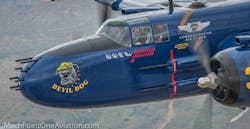WW II B-25 Gets a Lift with Paint Donation from Sherwin-Williams Aerospace Coatings
GEORGETOWN, Texas - When the B-25 bomber now known as the Devil Dog first took flight for the Allied forces in 1944, few could have predicted the signature dark blue paint, 16 machine guns and twin 1800 HP engines would still be a crowd pleaser at air shows more than 70 years later.
Now, thanks to the dedication of a Texas-based non-profit, the technical expertise of an Arkansas aircraft restoration shop, and a generous donation from Sherwin-Williams Aerospace Coatings, the Devil Dog looks as pristine as she did on her first mission in the Pacific theatre.
Today the Commemorative Air Force (CAF), a Texas-based non-profit dedicated to preserving, maintaining and operating historic United States military aircraft, operates and maintains the Devil Dog. The CAF’s Devil Dog Squadron facilitates the Devil Dog’s many air show appearances around the country each year. This means thousands of miles, and a bit of wear and tear.
Last year the all-volunteer Devil Dog Squadron agreed that the time had come for a new coating to protect the aircraft’s structural integrity and to restore its original brilliance.
To carry out the unique restoration project, the Devil Dog Squadron contracted with Crider Aviation of Mena, Arkansas. The shop’s owner, Roger Crider, says the project was a great opportunity to incorporate modern restoration practices to a widely-recognized historic aircraft.
As with any non-profit effort, raising funds for the restoration was an initial hurdle. Sherwin-Williams offered valuable assistance by donating the primer and topcoat necessary for the project.
“We used Sherwin-Williams Jet Glo® coating Conventional, in aristo blue,” said Crider. “Aircraft of this era typically had a flat finish, but that can be difficult to maintain. So we used 20 percent flattening paste to bring it to a semi-gloss.”
According to Crider, the project was a month-long effort that included chemically stripping the surface, some additional hand-cleaning, and extra care due to the fabric controls.
“There were some elements of this aircraft we don't run across too much these days,” said Crider. “We always want to take time to make sure the quality is right with a vintage aircraft.”
For more information on the Devil Dog Squadron, visit https://www.devildogsquadron.com/
For more information on Crider Aircraft Painting, visit http://www.aircraftpaintinginc.com/
For more information on Sherwin-Williams Aerospace coatings, visit https://www.swaerospace.com/home
